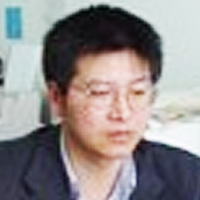Abstract
Mini Review
Role of T-Helper cells (CD4+ T Cells) in human immune system against some microbial infection: A mini review
Ali M*, Lurwan M, Salihi AM and Halliru SN
Published: 11 May, 2020 | Volume 3 - Issue 1 | Pages: 026-029
The human immune system consists of innate and adaptive immune responses which both provide protective immunity to microbial infection. The adaptive immune system consists of T and B cell which act as second line defense through production of neutralizing antibody by B cells and cytotoxic activity of CD8+ T cells. The CD4+ T-cell performs a central role in the immune responses. These cells also known as T4 or helper/inducer T lymphocytes recognize antigens presented by antigen presenting cells (APC) such as macrophages and monocytes. Once antigens such as bacteria and viruses are presented, CD4+ T lymphocytes orchestrate the body’s antigen-specific immune response by Coordinating B-lymphocyte production of antibodies to these antigens, producing cytokines and induction of cytotoxic T-lymphocytes. The paper was aimed to review the role of T-helper cells (CD4+ T cells) in human immune system against some microbial infections.
Read Full Article HTML DOI: 10.29328/journal.ijcmbt.1001012 Cite this Article Read Full Article PDF
Keywords:
Bacteria; CD4+ T cells; Immunity system; Virus
References
- Medzhitov R, Janeway C Jr. Innate immunity. N Engl J Med. 2000; 343: 338-344. PubMed: https://www.ncbi.nlm.nih.gov/pubmed/10922424
- Jawetz, Melnick, Adelberg. Medical Microbiology Twenty-Sixth Edition The McGraw-Hill Companies, Inc.; 2001.
- Iwasaki A, Medzhitov R. Toll-like receptor control of the adaptive immune responses. Nat Immunol. 2004; 5: 987-995. PubMed: https://www.ncbi.nlm.nih.gov/pubmed/15454922
- Hornef MW, Wick MJ, Rhen M, Normark S. Bacterial strategies for overcoming host innate and adaptive immune responses. Nat Immunol. 2002; 3: 1033-1040. PubMed: https://www.ncbi.nlm.nih.gov/pubmed/12407412
- Nair S, Bayer W, Ploquin M, Kassiotis G, Hasenkrug KG, et al. Distinct roles of CD4+ T cell subpopulations in retroviral immunity: lessons from the Friend virus mouse model. Retrovirology. 2011; 8: 76. PubMed: https://www.ncbi.nlm.nih.gov/pubmed/21943070
- Mosmann TR, Cherwinski H, Bond MW, Giedlin MA, Coffman RL. Two types of murine helper T cell clone. I. Definition according to profiles of lymphokine activities and secreted proteins. J Immunol. 1986; 136: 2348-2357. PubMed: https://www.ncbi.nlm.nih.gov/pubmed/2419430
- Kennedy R, Celis E. Multiple roles for CD4+ T cells in anti-tumor immune responses. Immunol Rev. 2008; 222: 129-144. PubMed: https://www.ncbi.nlm.nih.gov/pubmed/18363998
- Fayolle C, Deriaud E, Leclerc C. In vivo induction of cytotoxic T cell response by a free synthetic peptide requires CD4+ T cell help. J Immunol. 1991; 147: 4069-4073. PubMed: https://www.ncbi.nlm.nih.gov/pubmed/1684372
- Graham MB, Braciale VL, Braciale TJ. Influenza virus-specific CD4+ T helper type 2 T lymphocytes do not promote recovery from experimental virus infection. J Exp Med. 1994; 180: 1273-1282. PubMed: https://www.ncbi.nlm.nih.gov/pubmed/7931062
- Maloy KJ, Burkhart C, Freer G, Rulicke T, Pircher H, et al. Qualitative and quantitative re quirements for CD4+ T cellmediated antiviral protection. J Immunol. 1999; 162: 2867-2874. PubMed: https://www.ncbi.nlm.nih.gov/pubmed/10072535
- Mahon BP, Katrak K, Nomoto A, Macadam AJ, Minor PD, et al. Poliovirus-specific CD4+ Th1 clones with both cytotoxic and helper activity mediate protective humoral immunity against a lethal poliovirus infection in transgenic mice expressing the human poliovirus receptor. J Exp Med. 1995; 181: 1285-1292. PubMed: https://www.ncbi.nlm.nih.gov/pubmed/7699320
- Cardin RD, Brooks JW, Sarawar SR, Doherty PC. Progressive loss of CD8+ T cell-mediated control of a gamma-herpesvirus in the absence of CD4+ T cells. J Exp Med. 1996; 184: 863-871. PubMed: https://www.ncbi.nlm.nih.gov/pubmed/9064346
- Varga SM, Welsh RM. Stability of virus-specific CD4+ T cell frequencies from acute infection into long term memory. J Immunol. 1998; 161: 367-374. PubMed: https://www.ncbi.nlm.nih.gov/pubmed/9647245
- Manickan E, Rouse RJ, Yu Z, Wire WS, Rouse BT. Genetic immunization against herpes simplex virus. Protection is mediated by CD4+ T lymphocytes. J Immunol. 1995; 155: 259-265. PubMed: https://www.ncbi.nlm.nih.gov/pubmed/7602102
- Maloy KJ, Burkhart C, Junt TM, Odermatt B, Oxenius A, et al. CD4(+) T cell subsets during virus infection. Protective capacity depends on effector cytokine secretion and on migratory capability. J Exp Med. 2000; 191: 2159-2170. PubMed: https://www.ncbi.nlm.nih.gov/pubmed/10859340
- Reich A, Erlwein O, Niewiesk S, ter Meulen V, Liebert UG. CD4+ T cells control measles virus infection of the central nervous system. Immunology. 1992; 76: 185-191. PubMed: https://www.ncbi.nlm.nih.gov/pubmed/16529787
- Iwashiro M, Peterson K, Messer RJ, Stromnes IM, Hasenkrug KJ. CD4(+) T cells and gamma interferon in the long-term control of persistent friend retrovirus infection. J Virol. 2001; 75: 52-60. PubMed: https://www.ncbi.nlm.nih.gov/pubmed/11119573
- Gagnon SJ, Ennis FA, Rothman AL. Bystander target cell lysis and cytokine production by dengue virus-specific human CD4(+) cytotoxic Tlymphocyte clones. J Virol. 1999; 73: 3623-3629. PubMed: https://www.ncbi.nlm.nih.gov/pubmed/10196254
- Barnaba V, Franco A, Paroli M, Benvenuto R, De Petrillo G, et al. Selective expansion of cytotoxic T lymphocytes with a CD4+CD56+ surface phenotype and a T helper type 1 profile of cytokine secretion in the liver of patients chronically infected with Hepatitis B virus. J Immunol. 1994; 152: 3074-3087. PubMed: https://www.ncbi.nlm.nih.gov/pubmed/7511637
- Jacobson S, Richert JR, Biddison WE, Satinsky A, Hartzman RJ, et al. Measles virus-specific T4+ human cytotoxic T cell clones are restricted by class II HLA antigens. J Immunol. 1984; 133: 754-757. PubMed: https://www.ncbi.nlm.nih.gov/pubmed/6203977
- Yakushijin Y, Yasukawa M, Kobayashi Y. Establishment and functional characterization of human herpesvirus 6-specific CD4+ human T-cell clones. J Virol. 1992; 66: 2773-2779. PubMed: https://www.ncbi.nlm.nih.gov/pubmed/1348547
- Orentas RJ, Hildreth JE, Obah E, Polydefkis M, Smith GE, et al. Induction of CD4+ human cytolytic T cells specific for HIV infected cells by a gp160 subunit vaccine. Science. 1990; 248: 1234-1237. PubMed: https://www.ncbi.nlm.nih.gov/pubmed/2190315
- Bickham K, Munz C, Tsang ML, Larsson M, Fonteneau JF, et al. EBNA1-specific CD4+ T cells in healthy carriers of Epstein-Barr virus are primarily Th1 in function. J Clin Invest. 2001; 107: 121-130. PubMed: https://www.ncbi.nlm.nih.gov/pubmed/11134187
- Zhu J, Paul WE. CD4 T cells: fates, functions, and faults. Blood. 2008; 112: 1557-1569. PubMed: https://www.ncbi.nlm.nih.gov/pubmed/18725574
- McHeyzer-Williams LJ, McHeyzer-Williams MG. Antigen-specific memory B cell development. Annu Rev Immunol. 2005; 23: 487-513. PubMed: https://www.ncbi.nlm.nih.gov/pubmed/15771579
- Harrington LE, Hatton RD, Mangan PR, Turner H, Murphy TL, et al. Interleukin 17-producing CD4+ effector T cells develop via a lineage distinct from the T helper type 1 and 2 lineages. Nat Immunol. 2005; 6: 1123-1132. PubMed: https://www.ncbi.nlm.nih.gov/pubmed/16200070
- Park H, Li Z, Yang XO, Chang SH, Nurieva R, et al. A distinct lineage of CD4 T cells regulates tissue inflammation by producing interleukin 17. Nat Immunol. 2005; 6: 1133-1141. PubMed: https://www.ncbi.nlm.nih.gov/pubmed/16200068
- Yen D, Cheung J, Scheerens H, Poulet F, McClanahan T, et al. IL-23 is essential for T cell-mediated colitis and promotes inflammation via IL-17 and IL-6. J Clin Invest. 2006; 116: 1310-1316. PubMed: https://www.ncbi.nlm.nih.gov/pubmed/16670770
- Langrish CL, Chen Y, Blumenschein WM, Mattson J, Basham B, et al. IL-23 drives a pathogenic T cell population that induces autoimmune inflammation. J Exp Med. 2005; 201: 233-240. PubMed: https://www.ncbi.nlm.nih.gov/pubmed/15657292
- Breitfeld D, Ohl L, Kremmer E, Ellwart J, Sallusto F, et al. Follicular B helper T cells express CXC chemokine receptor 5, localize to B cell follicles, and support immunoglobulin production. J Exp Med. 2000; 192: 1545-1552. PubMed: https://www.ncbi.nlm.nih.gov/pubmed/11104797
- Crotty S. Follicular Helper CD4 T Cells (T(FH)). Annu Rev Immunol. 2011; 29: 621-663. PubMed: https://www.ncbi.nlm.nih.gov/pubmed/21314428
- Hughes MD, Johnson VA, Hirsch MS. Monitoring plasma HIV-1 RNA levels in addition to CD4+ lymphocyte count improves assessment of antiretroviral therapeutic response. Ann Intern Med. 1997; 126: 929-938. PubMed: https://www.ncbi.nlm.nih.gov/pubmed/9182469
- Wilson CB. The cellular immune system and its role in host defense, New York, NY: Churchill Livingstone Inc. 1990; 101-138.
- Bowen D, Lane H, Fauci A. Immuno-pathogenesis of the acquired immunodeficiency syndrome. Ann Intern Med. 1995; 103: 704-709. PubMed: https://www.ncbi.nlm.nih.gov/pubmed/2996403
- Beuneu H, Garcia Z, Bousso P. Cutting edge: cognate CD4 help promotes recruitment of antigen-specific CD8 T cells around dendritic cells. J Immunol. 2000; 177: 1406–1410. PubMed: https://www.ncbi.nlm.nih.gov/pubmed/16849444
- Castellino F, Huang AY, Altan-Bonnet G, Stoll S, Scheinecker C, et al. Chemokines enhance immunity by guiding naive CD8+ T cells to sites of CD4+ T celldendritic cell interaction. Nature. 2006; 440: 890–895. PubMed: https://www.ncbi.nlm.nih.gov/pubmed/16612374
- Teijaro JR, Verhoeven D, Page CA, Turner D, Farber DL. Memory CD4 T cells direct protective responses to influenza virus in the lungs through helper-independent mechanisms. J Virol.2010; 84: 9217–9226. PubMed: https://www.ncbi.nlm.nih.gov/pubmed/20592069
- Wiesel M, Oxenius A. From crucial to negligible: functional CD8+ T-cell responses and their dependence on CD4+ T-cell help. Eur JImmunol. 2012; 42: 1080–1088. PubMed: https://www.ncbi.nlm.nih.gov/pubmed/22539281
- Sette A, Rappuoli R. Reverse vaccinology: developing vaccines in the era of genomics. Immunity. 2010; 33: 530–541. PubMed: https://www.ncbi.nlm.nih.gov/pubmed/21029963
- Williams MA, Holmes BJ, Sun JC, Bevan MJ. Developing and maintaining protective CD8+ memory T cells. ImmunolRev. 2006; 211: 146–153. PubMed: https://www.ncbi.nlm.nih.gov/pubmed/16824124
- Aubert, RD, Kamphorst AO, Sarkar S, Vezys V, Ha SJ, et al. Antigen-specific CD4 T-cell help rescues exhausted CD8 T cells during chronic viral infection. Proc Natl Acad Sci USA. 2011; 108: 21182–21187. PubMed: https://www.ncbi.nlm.nih.gov/pubmed/22160724
- King C. A fine romance: T follicular helper cells and B cells. Immunity. 2011; 34: 827–829. PubMed: https://www.ncbi.nlm.nih.gov/pubmed/21703537
- Morita R, Schmitt N, Bentebibel SE, Ranganathan R, Bourdery L, et al. Human blood CXCR5(+)CD4(+) T cells are counterparts of T follicular cells and contain specific subsets that differentially support antibody secretion. Immunity. 2011; 34: 108–121. PubMed: https://www.ncbi.nlm.nih.gov/pubmed/21215658
- Swain SL, McKinstry KK, Strutt TM. Expanding roles for CD4+ T cells in immunity to viruses. Nat RevImmunol. 2012; 12: 136–148. PubMed: https://www.ncbi.nlm.nih.gov/pubmed/22266691
Similar Articles
-
Oral Candida colonization in HIV-infected patients: Species and antifungal susceptibility in Tripoli/LibyaEllabib M*,Mohamed H,Mokthar E,Ellabib M,El Magrahi H,Eshwika A. Oral Candida colonization in HIV-infected patients: Species and antifungal susceptibility in Tripoli/Libya . . 2018 doi: 10.29328/journal.ijcmbt.1001001; 1: 001-008
-
Knowledge, perception and practices of Suez Canal University students regarding Hepatitis C Virus infection risk and means of preventionNermine Elmaraghy*,Hesham El-Sayed,Sohair Mehanna,Adel Hassan,Mahmoud Sheded,Maha Abdel-Fattah,Samar Elfiky,Nehal Lotfy,Zeinab Khadr. Knowledge, perception and practices of Suez Canal University students regarding Hepatitis C Virus infection risk and means of prevention. . 2019 doi: 10.29328/journal.ijcmbt.1001007; 2: 020-027
-
in silico discovery of potential inhibitors against Dipeptidyl Peptidase-4: A major biological target of Type-2 diabetes mellitusNouman Rasool*,Andleeb Subhani,Waqar Hussain,Nadia Arif. in silico discovery of potential inhibitors against Dipeptidyl Peptidase-4: A major biological target of Type-2 diabetes mellitus. . 2020 doi: 10.29328/journal.ijcmbt.1001008; 3: 001-010
-
Development of ELISA based detection system against C. botulinum type BArti Sharma*,S Ponmariappan. Development of ELISA based detection system against C. botulinum type B. . 2020 doi: 10.29328/journal.ijcmbt.1001010; 3: 017-020
-
Role of T-Helper cells (CD4+ T Cells) in human immune system against some microbial infection: A mini reviewAli M*,Lurwan M,Salihi AM,Halliru SN. Role of T-Helper cells (CD4+ T Cells) in human immune system against some microbial infection: A mini review. . 2020 doi: 10.29328/journal.ijcmbt.1001012; 3: 026-029
-
Characterization of plastic degrading bacteria isolated from landfill sitesAfreen Bakht,Nouman Rasool*,Saima Iftikhar. Characterization of plastic degrading bacteria isolated from landfill sites. . 2020 doi: 10.29328/journal.ijcmbt.1001013; 3: 030-035
-
Hypochlorous acid has emerged as a potential alternative to conventional antibiotics due to its broad-spectrum antimicrobial activityMaher M Akl*. Hypochlorous acid has emerged as a potential alternative to conventional antibiotics due to its broad-spectrum antimicrobial activity. . 2023 doi: 10.29328/journal.ijcmbt.1001026; 6: 001-004
-
Comparative Evaluation of the Effectiveness of Methods for the Treatment of Surgical Soft Tissue InfectionAO Okhunov*. Comparative Evaluation of the Effectiveness of Methods for the Treatment of Surgical Soft Tissue Infection. . 2023 doi: 10.29328/journal.ijcmbt.1001027; 6: 005-011
-
Trends of Antibiotic Resistance among Uropathogens in Medical vs. Non-Medical Departments of Al-Shifa Medical Complex in Gaza Strip: A Retrospective, Cross-Sectional StudyKhaled Alkhodari*, Yasmin Al-Shurafa, Hammam AL-louh, Rafat Lubbad. Trends of Antibiotic Resistance among Uropathogens in Medical vs. Non-Medical Departments of Al-Shifa Medical Complex in Gaza Strip: A Retrospective, Cross-Sectional Study. . 2024 doi: 10.29328/journal.ijcmbt.1001028; 7: 001-005
-
From the Single Bacterial Cell to the Microbial Community: A Round Trip to better understand the Secrets of Complex Microbiological EcosystemsErasmo Neviani*. From the Single Bacterial Cell to the Microbial Community: A Round Trip to better understand the Secrets of Complex Microbiological Ecosystems. . 2024 doi: 10.29328/journal.ijcmbt.1001029; 7: 006-008
Recently Viewed
-
Metabolic syndrome: A case reportDragan Klaric,Marta Martinis*,Marta Klaric. Metabolic syndrome: A case report. Ann Clin Endocrinol Metabol. 2021: doi: 10.29328/journal.acem.1001022; 5: 031-035
-
Hypercalcaemic Crisis Associated with Hyperthyroidism: A Rare and Challenging PresentationKarthik Baburaj*, Priya Thottiyil Nair, Abeed Hussain, Vimal MV. Hypercalcaemic Crisis Associated with Hyperthyroidism: A Rare and Challenging Presentation. Ann Clin Endocrinol Metabol. 2024: doi: 10.29328/journal.acem.1001029; 8: 001-003
-
Evaluation of novel culture media prepared from plant substrates for isolation and identification of Cryptococcus Neoformans Species ComplexEllabib M*,Krema ZA,Mokthar ES,El Magrahi HS,Eshwika A,Cogliati M. Evaluation of novel culture media prepared from plant substrates for isolation and identification of Cryptococcus Neoformans Species Complex. Int J Clin Microbiol Biochem Technol. 2018: doi: 10.29328/journal.ijcmbt.1001002; 1: 009-013
-
A Review on filaricidal activity of phytochemical extracts against filariasis and the Parasites Genomic DiversityAM Gumel*,MM Dogara. A Review on filaricidal activity of phytochemical extracts against filariasis and the Parasites Genomic Diversity. Int J Clin Microbiol Biochem Technol. 2018: doi: 10.29328/journal.ijcmbt.1001004; 1: 024-032
-
Trends of Antibiotic Resistance among Uropathogens in Medical vs. Non-Medical Departments of Al-Shifa Medical Complex in Gaza Strip: A Retrospective, Cross-Sectional StudyKhaled Alkhodari*, Yasmin Al-Shurafa, Hammam AL-louh, Rafat Lubbad. Trends of Antibiotic Resistance among Uropathogens in Medical vs. Non-Medical Departments of Al-Shifa Medical Complex in Gaza Strip: A Retrospective, Cross-Sectional Study. Int J Clin Microbiol Biochem Technol. 2024: doi: 10.29328/journal.ijcmbt.1001028; 7: 001-005
Most Viewed
-
Impact of Latex Sensitization on Asthma and Rhinitis Progression: A Study at Abidjan-Cocody University Hospital - Côte d’Ivoire (Progression of Asthma and Rhinitis related to Latex Sensitization)Dasse Sery Romuald*, KL Siransy, N Koffi, RO Yeboah, EK Nguessan, HA Adou, VP Goran-Kouacou, AU Assi, JY Seri, S Moussa, D Oura, CL Memel, H Koya, E Atoukoula. Impact of Latex Sensitization on Asthma and Rhinitis Progression: A Study at Abidjan-Cocody University Hospital - Côte d’Ivoire (Progression of Asthma and Rhinitis related to Latex Sensitization). Arch Asthma Allergy Immunol. 2024 doi: 10.29328/journal.aaai.1001035; 8: 007-012
-
Causal Link between Human Blood Metabolites and Asthma: An Investigation Using Mendelian RandomizationYong-Qing Zhu, Xiao-Yan Meng, Jing-Hua Yang*. Causal Link between Human Blood Metabolites and Asthma: An Investigation Using Mendelian Randomization. Arch Asthma Allergy Immunol. 2023 doi: 10.29328/journal.aaai.1001032; 7: 012-022
-
An algorithm to safely manage oral food challenge in an office-based setting for children with multiple food allergiesNathalie Cottel,Aïcha Dieme,Véronique Orcel,Yannick Chantran,Mélisande Bourgoin-Heck,Jocelyne Just. An algorithm to safely manage oral food challenge in an office-based setting for children with multiple food allergies. Arch Asthma Allergy Immunol. 2021 doi: 10.29328/journal.aaai.1001027; 5: 030-037
-
Snow white: an allergic girl?Oreste Vittore Brenna*. Snow white: an allergic girl?. Arch Asthma Allergy Immunol. 2022 doi: 10.29328/journal.aaai.1001029; 6: 001-002
-
Cytokine intoxication as a model of cell apoptosis and predict of schizophrenia - like affective disordersElena Viktorovna Drozdova*. Cytokine intoxication as a model of cell apoptosis and predict of schizophrenia - like affective disorders. Arch Asthma Allergy Immunol. 2021 doi: 10.29328/journal.aaai.1001028; 5: 038-040

If you are already a member of our network and need to keep track of any developments regarding a question you have already submitted, click "take me to my Query."















































































































































